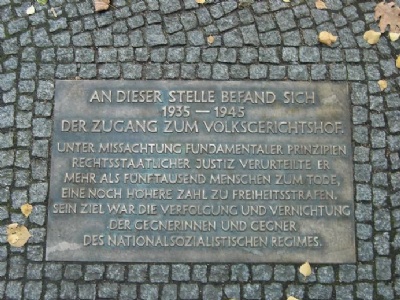Berlin – People’s Court
In 1934, the People’s Court (german Volksgerichtshof) was founded as a consequence of the failed trial of those accused of the Berlin Reichstag fire in February 1933. Four of the five suspected communists accused of the fire were acquitted. In order to avoid similar failure, the Courtl was founded whose main task was to deal with cases of a political nature. Through the People’s Court, Hitler could be sure that the verdict was in accordance with his own wishes and thus a political tool. Thus political justice became what was in the interest of Nazism. The Court was located all over Germany, but its main seat was at Bellevuestrasse 15 at Potsdamer Platz in Berlin.
Until 1936, the People’s Court was designated as a Special Court but became an independent court by law from April 1936, whose members were appointed by Hitler personally. The first president of the court was Otto Thierack (Justice minister between 1943 and 1945), but in 1942 the post was taken over by the notorious and unscrupulous Roland Freisler. The People’s court gave Hitler a form of legitimacy when he could refer to the fact that people accused were brought to justice and sentenced based on the laws that applied. Between 1942 and 1944, the court issued almost 5,000 death sentences and it is the brutality of the court that made it so notorious. Roland Freisler took on several cases and the most famous are the trials of Hans and Sophie Scholl and other members of the resistance group White Rose as well as the trial of the conspirators who were behind the assassination attempt against Hitler on July 20, 1944.
Current status: Demolished with memorial tablet (2010).
Address: Bellevuestrasse, 10785 Berlin.
Get there: Metro to Potsdamer Platz
Follow up in books: Koch, H.W: In the name of the Volk: Political Justice in Hitler’s Germany (1989).

The People’s Court office was badly damaged during the war and during a bombing on February 3, 1945, Roland Freisler was killed. Freisler had if he survived the war certainly been one of the accused at the main trial in Nuremberg. He had hardly escaped the death penalty. In 1985, the German court ruled that the People’s court was not a legal court but rather an instrument for the Nazi regime to issue judgments for its own purposes. After the war, several of the judges and prosecutors who worked for the Court came to serve in West German and East German courts. Simply because that there were not enough prosecutors and judges to meet the needs of the judiciary in these countries. This became problematic when the west German courts brought Nazi war criminals to justice.